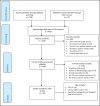Assessment of dietary sodium intake using a food frequency questionnaire and 24-hour urinary sodium excretion: a systematic literature review
- PMID: 29220554
- PMCID: PMC8030845
- DOI: 10.1111/jch.13148
Assessment of dietary sodium intake using a food frequency questionnaire and 24-hour urinary sodium excretion: a systematic literature review
Abstract
Food frequency questionnaires (FFQs) are often used to assess dietary sodium intake, although 24-hour urinary excretion is the most accurate measure of intake. The authors conducted a systematic review to investigate whether FFQs are a reliable and valid way of measuring usual dietary sodium intake. Results from 18 studies are described in this review, including 16 validation studies. The methods of study design and analysis varied widely with respect to FFQ instrument, number of 24-hour urine collections collected per participant, methods used to assess completeness of urine collections, and statistical analysis. Overall, there was poor agreement between estimates from FFQ and 24-hour urine. The authors suggest a framework for validation and reporting based on a consensus statement (2004), and recommend that all FFQs used to estimate dietary sodium intake undergo validation against multiple 24-hour urine collections.
Keywords: diet surveys; sodium dietary; urine specimen collection.
©2017 Wiley Periodicals, Inc.
Conflict of interest statement
NC is a member of World Action on Salt and Health (a dietary salt reduction organization) and is a paid consultant for the Novartis Foundation, which involves travel expenses and personal fees for site visits; received a one‐time contract (2016) to develop a survey; and was a paid member of an advisory board for Midmark in 2017. The other authors have no conflicts of interest to disclose.
Figures
Similar articles
-
A rapid and systematic review of the clinical effectiveness and cost-effectiveness of topotecan for ovarian cancer.Health Technol Assess. 2001;5(28):1-110. doi: 10.3310/hta5280. Health Technol Assess. 2001. PMID: 11701100
-
Home treatment for mental health problems: a systematic review.Health Technol Assess. 2001;5(15):1-139. doi: 10.3310/hta5150. Health Technol Assess. 2001. PMID: 11532236
-
Cost-effectiveness of using prognostic information to select women with breast cancer for adjuvant systemic therapy.Health Technol Assess. 2006 Sep;10(34):iii-iv, ix-xi, 1-204. doi: 10.3310/hta10340. Health Technol Assess. 2006. PMID: 16959170
-
Drugs for preventing postoperative nausea and vomiting in adults after general anaesthesia: a network meta-analysis.Cochrane Database Syst Rev. 2020 Oct 19;10(10):CD012859. doi: 10.1002/14651858.CD012859.pub2. Cochrane Database Syst Rev. 2020. PMID: 33075160 Free PMC article.
-
The measurement and monitoring of surgical adverse events.Health Technol Assess. 2001;5(22):1-194. doi: 10.3310/hta5220. Health Technol Assess. 2001. PMID: 11532239
Cited by
-
Prospective Associations between Cumulative Average Intake of Flavonoids and Hypertension Risk in the CArdioVascular Disease Association Study (CAVAS).Nutrients. 2023 Feb 27;15(5):1186. doi: 10.3390/nu15051186. Nutrients. 2023. PMID: 36904184 Free PMC article.
-
Association of Sodium, Potassium and Sodium-to-Potassium Ratio with Urine Albumin Excretion among the General Chinese Population.Nutrients. 2021 Sep 29;13(10):3456. doi: 10.3390/nu13103456. Nutrients. 2021. PMID: 34684456 Free PMC article.
-
The Science of Salt: Updating the evidence on global estimates of salt intake.J Clin Hypertens (Greenwich). 2019 Jun;21(6):710-721. doi: 10.1111/jch.13546. Epub 2019 Apr 29. J Clin Hypertens (Greenwich). 2019. PMID: 31033166 Free PMC article. Review.
-
Sources of Dietary Salt in North and South India Estimated from 24 Hour Dietary Recall.Nutrients. 2019 Feb 1;11(2):318. doi: 10.3390/nu11020318. Nutrients. 2019. PMID: 30717304 Free PMC article.
-
Relative validity of a Diet Risk Score (DRS) for Chinese American adults.BMJ Nutr Prev Health. 2023 Jun;6(1):76-82. doi: 10.1136/bmjnph-2022-000509. Epub 2023 Mar 9. BMJ Nutr Prev Health. 2023. PMID: 37484538 Free PMC article.
References
-
- Campbell NR. Dissidents and dietary sodium: concerns about the commentary by O'Donnell et al. Int J Epidemiol. 2016;46:362‐366. - PubMed
-
- Campbell NR, Lackland DT, Niebylski ML. 2014 dietary salt fact sheet of the World Hypertension League, International Society of Hypertension, Pan American Health Organization technical advisory group on cardiovascular disease prevention through dietary salt reduction, the World Health Organization collaborating centre on population salt reduction, and World Action on Salt & Health. J Clin Hypertens (Greenwich). 2015;17:7‐9. - PMC - PubMed
Publication types
MeSH terms
Substances
LinkOut - more resources
Full Text Sources
Other Literature Sources
Medical


